Every year, thousands of Bar-headed Geese make an epic journey, twice crossing the mighty Himalayas over some of the highest peaks in the world. In doing so, they fly higher than any other bird in the world and faster than most others. It’s an inspirational story of tenacity and physical endurance, which even inspires poetry (of a sort!) in some people. Read on to learn more about this fascinating species.
Size: 71-76 cm; Weight: 2-3 Kg. Unmistakable; sexes alike; juvenile has pale grey head and neck with brown stripe running though eyes, across crown and backward down the neck. Forages mostly on land by grazing; feeds on grasses, roots, stems, sea-weeds on coasts, etc. Breeds on mountain lakes generally at 4,000-5,000m in the Palaearctic region and winters in the lowland swamps and lakes in India and some neighbouring countries.1

The Bar-headed Goose is among our most good-looking and charismatic migrants; but there is more to this beauty than meets the eye. Every year the species embarks on one of the most incredible high altitude migrations known from the avian world.
The Bar-headed Goose breeds near wetlands across the vast trans-Himalayan highland, and further north in Central Asia. During winter, a large number of these birds migrate to the Indian subcontinent, crossing the towering Greater Himalayan range before panning out across the region, all the way to Kanyakumari. Incredibly, some populations are known to over-fly the very highest peaks, 8km above sea-level, where the air is extremely thin (Oxygen pressure only a third of that at sea level) and incredibly cold (sometimes below -50 degrees C) 2. A recent study that tracked the migration of Bar-headed geese using satellite telemetry states that “The bar-headed geese… actually crossed mountain areas regardless of their height and did not avoid even very high summits… (One of the individuals) had to overcome the Tien Shan Mountains and the Alai Range, with summits up to 7km above sea level.3”
This migration is remarkable not only because of the altitude at which the birds fly but also the speed at which it happens. Using jet streams these birds can achieve speeds of over 150km per hour, and cover distances of 700-1,000km in a single day 2. In other words, an individual that takes off from a wetland in north India, reaches altitudes over 7km in a few hours, crosses the Himalayas, and lands in Tibet, all in the same day!
Bar-headed Geese have physiological adaptations that help it achieve this feat of a migration that few other animals can possibly survive2. It has a large heart which beats extraordinarily fast and haemoglobin with a remarkably high affinity to oxygen making it possible for the bird to take on high-altitude flight without any time to acclimatise2. Also, their wings are rather large and they are powerful flappers4.
So this is clearly a star migrant that is built to fly high. But why it chooses to fly over the highest peaks instead of using lower passes is a question yet to be answered.

The current global population of the species is estimated at around 52,000-60,000 mature individuals and a range (breeding and winter) of 2,370,000 sq km 5. But it is possible that the distribution of the species might be dramatically altered in the future because of global warming, change in agricultural patterns, the creation of wildlife reserves in Tibet, and loss of wetland habitat in the wintering grounds6.
Global Distribution Map © WWF Wild Finder
In India, we have a population of the Bar-headed Goose that breeds in the wetlands of Ladakh, but for the rest of the country, this species is a winter migrant7. Its distribution in winter stretches across the northern plains and southwards to the southern most tip of the country8.


MAPS – (a) Sightings on MigrantWatch and BirdSpot9 (b) First sightings (2008 to 12 Dec 2010) in the MigrantWatch database
The birds arrive in India in November and migrate back to their breeding areas around mid March6. According to MigrantWatch data, the species is usually first sighted across the northern pains in Nov-Dec and in south India in Dec-Jan.
Conservation
The Bar-headed Goose is currently categorized as ‘Least Concern’ under the IUCN Red List, which means that it is not considered to be under threat. However, there are reports that the population has been affected adversely in recent decades due to hunting by humans, unsustainable levels of egg collecting and habitat destruction1,3. In addition to persecution by humans, this species is also known to face serious threats from disease. High mortality of these birds was recorded from lakes in China in 2005 during an outbreak of the H5N1 strain of avian influenza 2. The species may also be sensitive to climate change if migration patterns become mistimed with periods of peak food availability during the breeding season6.
Satellite tracking
In recent years some research on the migration of this goose has been taken up using satellite telemetry. One such study found that the individuals that were captured in the wintering grounds of India-Nepal migrated distances of 500-800 km and climbed more than 4.5 km to reach their breeding grounds on the Tibetan plateau. Geese captured in China were found to be breeding and wintering in relatively higher elevations – wintering at 4,000 m and breeding at 3,200 m, but migrating 400-800 km farther than the geese from India-Nepal. Finally, geese captured in Mongolia demonstrated a leapfrog migration – i.e. they were flying over the other sub-population from their wintering grounds in the Indian subcontinent to their breeding grounds in Mongolia 6.
 MAP – Locations (circles), migration pathways (lines), and capture areas for 60 Bar-headed Geese marked with satellite transmitters in China (red), India (yellow), Mongolia (green), and Nepal (blue). The red-dotted line between China and Mongolia represents a goose marked pre-breeding (April) at Qinghai Lake, China which migrated to Mongolia for breeding; all other red lines represent birds marked post-breeding at Qinghai Lake.6
MAP – Locations (circles), migration pathways (lines), and capture areas for 60 Bar-headed Geese marked with satellite transmitters in China (red), India (yellow), Mongolia (green), and Nepal (blue). The red-dotted line between China and Mongolia represents a goose marked pre-breeding (April) at Qinghai Lake, China which migrated to Mongolia for breeding; all other red lines represent birds marked post-breeding at Qinghai Lake.6
Another study that followed migratory geese in Kyrgyzstan fond that the four individuals marked in Kyrgyzstan followed three completely different migration routes leading to their wintering areas in Pakistan, India and Uzbekistan via southern Tajikistan and in western Tibet 3. The study also recorded flight speeds of up to 680 km per actual migration day, even during crossings of very high summits 3.
The Bar-headed Goose is a remarkable bird in many ways. It is amazing think that these birds can simply wake up one morning, take a test flight to check the winds, and decide to simply fly over the highest mountain range on the planet. How lucky we are to be on the other side of this flight to see these geese land noisily on our waterfront!
 The Anser – by Uttara Mediratta & M. O. Anand
The Anser – by Uttara Mediratta & M. O. Anand
How many peaks must a goose fly above
before it can earn its stripes?
Now, how many days must a goose fly strong
before it reaches its home?
Yes, how many blizzards must it face
before it can see the sun?
The Anser my friend is blowin’ in the wind
The Anser is blowin’ in the wind …
(with partial credit to Bob Dylan)
Illustration – Sartaj Ghuman
References
1. del Hoyo, J., Elliott, A. & Sargatal. 1992. J. Handbook of the Birds of the World: Vol 1 : Ostrich to ducks. Lynx Edicions.
2. Newton, I. 2008. The Migration Ecology of Birds. Elsevier Academic Press.
3. Köppen, U., Yakovlev, A.P., Barth, R., Kaatz, M. & Berthold, P. 2010. Seasonal migrations of four individual bar-headed geese Anser indicus from Kyrgyzstan followed by satellite telemetry. Journal of Ornithology 151, 703-712.
4. Whiteman, Lily. 2000. The High Life. Audubon Magazine. Downloaded from <http://audubonmagazine.org/birds/birds0011.html>
5. BirdLife International. (2010) Species factsheet: Anser indicus. Downloaded from <http://www.birdlife.org/datazone/speciesfactsheet.php?id=379>
6. Takekawa, J.Y. et al. 2009. Geographic variation in bar-headed geese Anser indicus: connectivity of wintering areas and breeding grounds across a broad front. Wild Fowl 59, 102-125.
7. Rasmussen, P.C. & Anderton, J.C. 2005. Birds of South Asia: The Ripley Guide. Volumes 1 & 2. Lynx Edicions.
8. Krishnan, M. Occurrence of the Bar-headed Goose (Anser indicus) in south India. Journal of the Bombay Natural History Society 84, 204
9. Shyamal, L. BirdSpot. Accessible from <http://sites.google.com/site/birdspot/home>
Relevant Links –
Videos and other information on BBC Wildlife Finder
Bar-headed Goose Bibliography on AVIS-IBIS (An Avian Information System – Indian BioDiversity Information System)
BirdLife International’s summary sheets on Bar-Headed Goose
Bar-headed Goose on MigrantWatch: Sighting data || Species Identification Guide
(Update on 8 June)
New research (by the BNHS and others) on Bar-headed Geese based on satellite-tracking shows that the geese display amazing feats while crossing the Himalayas on migration. They can climb many thousand metres in altitude in only a few hours; and do so without the assistance of tailwinds. Wonderful studies like this add greatly our understanding of Bar-headed Goose migration!
Press coverage:
Wise geese chase sinks a myth – Telegraph (Kolkata)
High-flying geese don’t need winds – The Hindu
The Most Extreme Migration on Earth? – Science Now
The original research article:
The trans-Himalayan flights of Bar-headed Geese.
 the mass-hunting of migrating Amur Falcons in Nagaland. These superb little raptors migrate from their breeding grounds in and around northeastern China all the way through India and to their wintering quarters in southern Africa. Along the way they gather in large numbers in northeastern India, where they are vulnerable to being caught.
the mass-hunting of migrating Amur Falcons in Nagaland. These superb little raptors migrate from their breeding grounds in and around northeastern China all the way through India and to their wintering quarters in southern Africa. Along the way they gather in large numbers in northeastern India, where they are vulnerable to being caught.

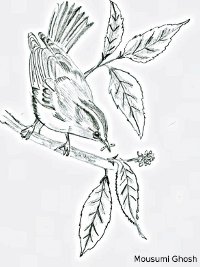 conveniently ignored every warbler I saw
conveniently ignored every warbler I saw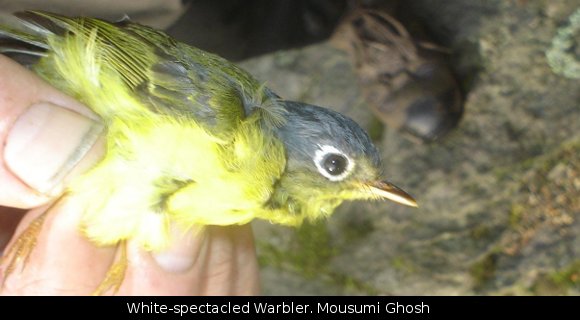
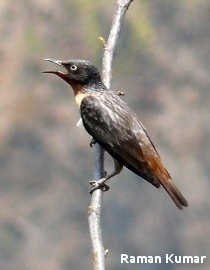
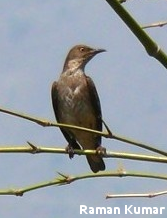
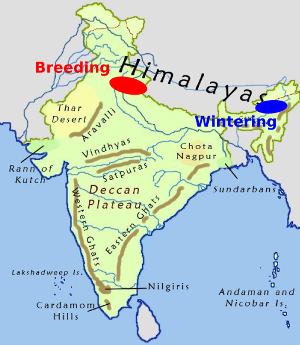

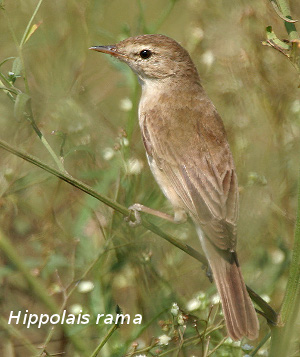
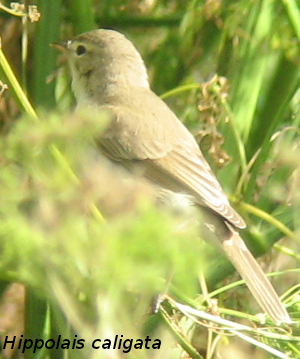

 yellow collar around its neck. Through my binoculars I could read the letters “NU”, and I was able to click a few images with these letters clearly visible. But what did “NU” mean?
yellow collar around its neck. Through my binoculars I could read the letters “NU”, and I was able to click a few images with these letters clearly visible. But what did “NU” mean?
 This year, 2011, I started monitoring the lake from 10 November. On 24 November 2011, Rakhee, Chaitanya and I, together with birdwatcher Avinash, saw a flock of 275-300 Bar-headed Geese. I started searching the flock for NU. Euphoria !!! she was there !!! As usual I clicked a few photos.
This year, 2011, I started monitoring the lake from 10 November. On 24 November 2011, Rakhee, Chaitanya and I, together with birdwatcher Avinash, saw a flock of 275-300 Bar-headed Geese. I started searching the flock for NU. Euphoria !!! she was there !!! As usual I clicked a few photos. Among these Lesser Sand Plovers was a smaller and slimmer bird with yellow legs and pearly edged wings. What could this be? We were intrigued.
Among these Lesser Sand Plovers was a smaller and slimmer bird with yellow legs and pearly edged wings. What could this be? We were intrigued. We whittled down our “differential diagnosis” of the bird to three species:
We whittled down our “differential diagnosis” of the bird to three species:
 The picture of the bird was sent all around the world by MigrantWatch and others. We are thankful to Praveen J., Sashikumar, Aasheesh Pittie, Bill Harvey, Rex De-Silva and Krys Kazmierczak for having identified the bird as the Buff-breasted Sandpiper.
The picture of the bird was sent all around the world by MigrantWatch and others. We are thankful to Praveen J., Sashikumar, Aasheesh Pittie, Bill Harvey, Rex De-Silva and Krys Kazmierczak for having identified the bird as the Buff-breasted Sandpiper.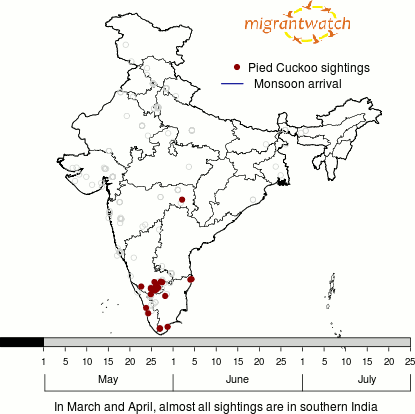 To illustrate the general pattern of migration of this species, we have put together this animated map, which shows the progression of Pied Cuckoo migration across the country in advance of the monsoon.
To illustrate the general pattern of migration of this species, we have put together this animated map, which shows the progression of Pied Cuckoo migration across the country in advance of the monsoon.



 MAP – Locations (circles), migration pathways (lines), and capture areas for 60 Bar-headed Geese marked with satellite transmitters in China (red), India (yellow), Mongolia (green), and Nepal (blue). The red-dotted line between China and Mongolia represents a goose marked pre-breeding (April) at Qinghai Lake, China which migrated to Mongolia for breeding; all other red lines represent birds marked post-breeding at Qinghai Lake.6
MAP – Locations (circles), migration pathways (lines), and capture areas for 60 Bar-headed Geese marked with satellite transmitters in China (red), India (yellow), Mongolia (green), and Nepal (blue). The red-dotted line between China and Mongolia represents a goose marked pre-breeding (April) at Qinghai Lake, China which migrated to Mongolia for breeding; all other red lines represent birds marked post-breeding at Qinghai Lake.6 The Anser – by Uttara Mediratta & M. O. Anand
The Anser – by Uttara Mediratta & M. O. Anand